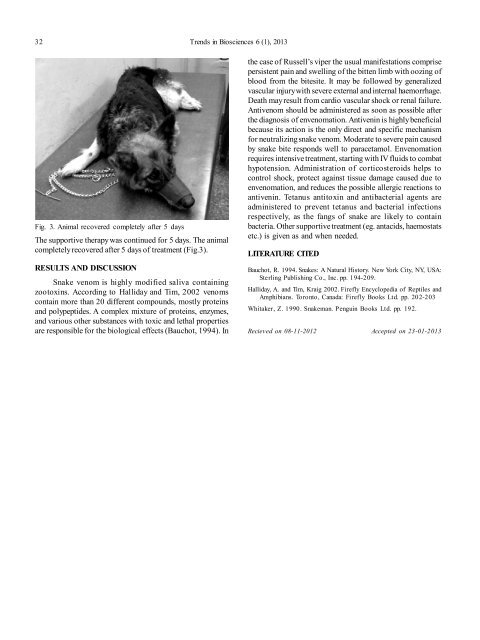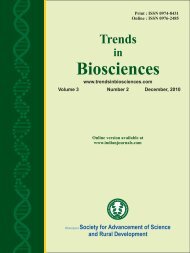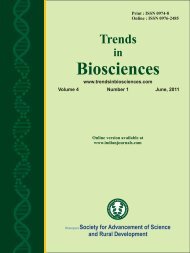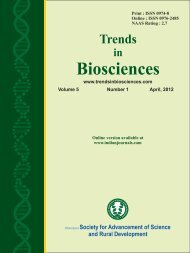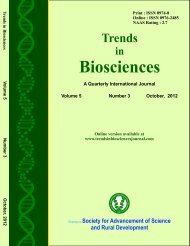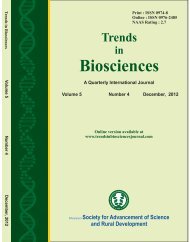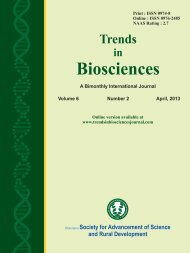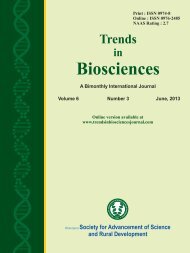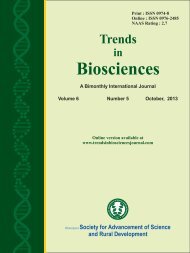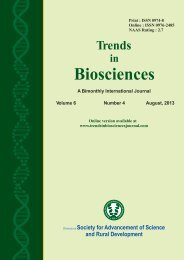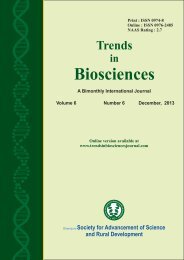TRENDS IN BIOSCIENCES 6-1, 2013 EDITION
CALL FOR RESEARCH PAPERS
CALL FOR RESEARCH PAPERS
You also want an ePaper? Increase the reach of your titles
YUMPU automatically turns print PDFs into web optimized ePapers that Google loves.
32 Trends in Biosciences 6 (1), <strong>2013</strong><br />
Fig. 3. Animal recovered completely after 5 days<br />
The supportive therapy was continued for 5 days. The animal<br />
completely recovered after 5 days of treatment (Fig.3).<br />
RESULTS AND DISCUSSION<br />
Snake venom is highly modified saliva containing<br />
zootoxins. According to Halliday and Tim, 2002 venoms<br />
contain more than 20 different compounds, mostly proteins<br />
and polypeptides. A complex mixture of proteins, enzymes,<br />
and various other substances with toxic and lethal properties<br />
are responsible for the biological effects (Bauchot, 1994). In<br />
the case of Russell’s viper the usual manifestations comprise<br />
persistent pain and swelling of the bitten limb with oozing of<br />
blood from the bitesite. It may be followed by generalized<br />
vascular injury with severe external and internal haemorrhage.<br />
Death may result from cardio vascular shock or renal failure.<br />
Antivenom should be administered as soon as possible after<br />
the diagnosis of envenomation. Antivenin is highly beneficial<br />
because its action is the only direct and specific mechanism<br />
for neutralizing snake venom. Moderate to severe pain caused<br />
by snake bite responds well to paracetamol. Envenomation<br />
requires intensive treatment, starting with IV fluids to combat<br />
hypotension. Administration of corticosteroids helps to<br />
control shock, protect against tissue damage caused due to<br />
envenomation, and reduces the possible allergic reactions to<br />
antivenin. Tetanus antitoxin and antibacterial agents are<br />
administered to prevent tetanus and bacterial infections<br />
respectively, as the fangs of snake are likely to contain<br />
bacteria. Other supportive treatment (eg. antacids, haemostats<br />
etc.) is given as and when needed.<br />
LITERATURE CITED<br />
Bauchot, R. 1994. Snakes: A Natural History. New York City, NY, USA:<br />
Sterling Publishing Co., Inc. pp. 194-209.<br />
Halliday, A. and Tim, Kraig 2002. Firefly Encyclopedia of Reptiles and<br />
Amphibians. Toronto, Canada: Firefly Books Ltd. pp. 202-203<br />
Whitaker, Z. 1990. Snakeman. Penguin Books Ltd. pp. 192.<br />
Recieved on 08-11-2012 Accepted on 23-01-<strong>2013</strong>


